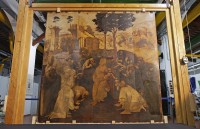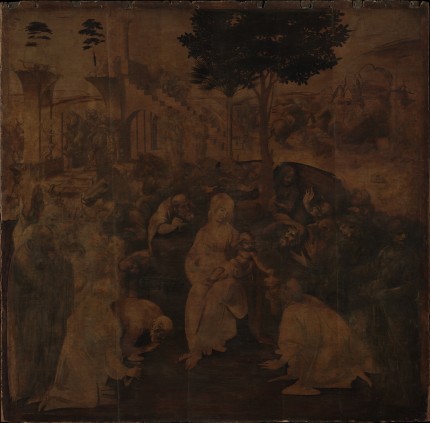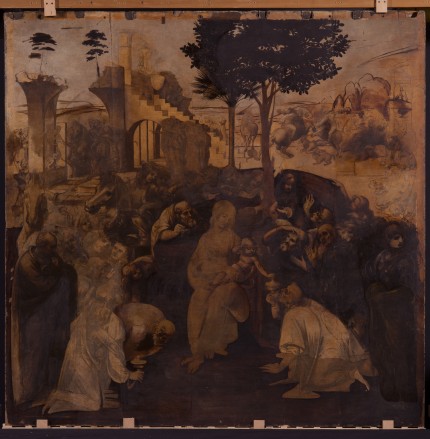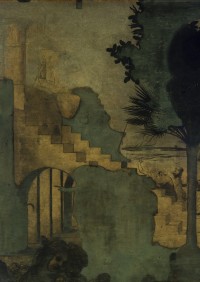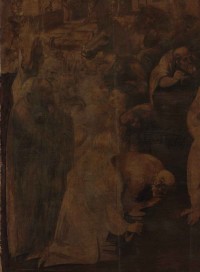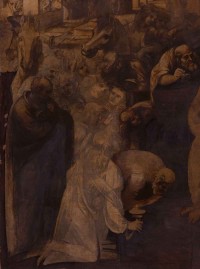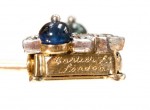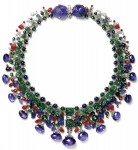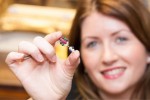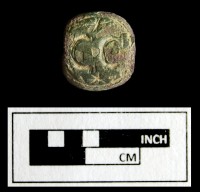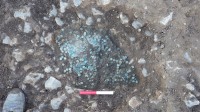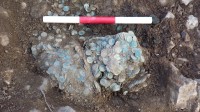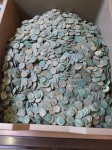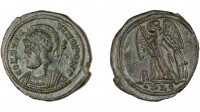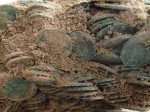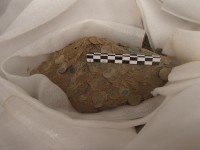
In 2012, Auckland University archaeologists recovered the remains of a canoe from a sand dune near the Anaweka estuary on South Island, New Zealand, after it had been exposed by a storm. It’s a 20-foot-long section of the hull carved from a single timber of New Zealand matai wood which was preserved by the waterlogged, low-oxygen environment. The top side is straight, the other curves up to a point. The point is the end of the canoe hull while the other end is a flat butt joint where a second section of hull was once connected. Adze marks are visible inside the hull section. The outside has been smoothly finished so the vessel can cut through the water with minimum drag.
Four transverse ribs are carved into the inside of the hull at regular intervals and a horizontal girder intersects the ribs down the length of the piece. Because the ribs are heavier on the side with the curved end, that was probably the lower side of the canoe. This is the first time these kinds of ribs have been documented in New Zealand, although they were reported in the Southern Cook Islands just a hundred years ago.
The edges are perforated with lashing holes chiseled through the wood. Four of them are still packed with caulking made from pounded wads of bark (probably from the totara tree). Radiocarbon dating performed on three wood samples from different areas of the hull and four caulking samples taken from three of the lashings returned a result of around 1400 A.D. for the last time the canoe was caulked.
 That’s enormously significant as Wairau Bar, a settlement on the northeastern coast of South Island that is the earliest known colonization, dated to the early 1300s. The Anaweka canoe, therefore, was in use within a century of colonization. There is only one other surviving canoe from early colonization found more than 30 years ago in the Society Islands 2,500 miles away from South Island. Archaeologists have had little to go on to reconstruct the ocean-going canoes Polynesians used for maritime migration and long-distance travel between islands after colonization. The main sources have been observations by European explorers centuries later and analysis of canoe-related vocabulary in Austronesian languages. This new find lends rare insight into the maritime technology that drove the East Polynesian settlement of New Zealand.
That’s enormously significant as Wairau Bar, a settlement on the northeastern coast of South Island that is the earliest known colonization, dated to the early 1300s. The Anaweka canoe, therefore, was in use within a century of colonization. There is only one other surviving canoe from early colonization found more than 30 years ago in the Society Islands 2,500 miles away from South Island. Archaeologists have had little to go on to reconstruct the ocean-going canoes Polynesians used for maritime migration and long-distance travel between islands after colonization. The main sources have been observations by European explorers centuries later and analysis of canoe-related vocabulary in Austronesian languages. This new find lends rare insight into the maritime technology that drove the East Polynesian settlement of New Zealand.
When intact, the canoe was probably at least 46 feet long. Archaeologists believe it was a double canoe, although it could also have been a single with an outrigger. It was a large, complex composite of planked and dugout canoe, an adaptation of East Polynesian maritime technology developed in the wake of the colonization of New Zealand. The form required very large trees to produce, trees that would only have been available to the Polynesians after settlement in New Zealand.
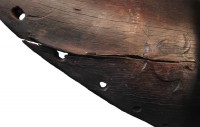 A raised relief of a sea turtle is carved into the outer hull at the curved end. A carved ridge runs behind the turtle to the very edge of the hull. Archaeologists believe the ridge may depict the wake of the turtle as it swims, which may be a clue to which way the canoe moved through the water (matching the direction of the turtle, that is). This is a spectacular feature, not just because it’s adorable but because it’s a clear representation of Polynesian culture. The Maori rarely used turtles as decorative motifs before the arrival of Europeans, but turtles are all over Polynesian art. Sea turtles are known to make very long ocean voyages, so they were more than appropriate spirit animals for the people who colonized the Pacific, and they make fine figureheads for the ocean-going canoes that made colonization possible.
A raised relief of a sea turtle is carved into the outer hull at the curved end. A carved ridge runs behind the turtle to the very edge of the hull. Archaeologists believe the ridge may depict the wake of the turtle as it swims, which may be a clue to which way the canoe moved through the water (matching the direction of the turtle, that is). This is a spectacular feature, not just because it’s adorable but because it’s a clear representation of Polynesian culture. The Maori rarely used turtles as decorative motifs before the arrival of Europeans, but turtles are all over Polynesian art. Sea turtles are known to make very long ocean voyages, so they were more than appropriate spirit animals for the people who colonized the Pacific, and they make fine figureheads for the ocean-going canoes that made colonization possible.
